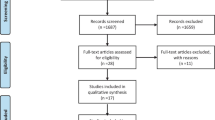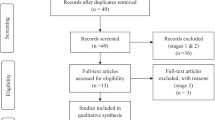Abstract
Maximal aerobic capacity measured as peak oxygen consumption (VO2peak), muscle strength, and muscle hypertrophy are the potent predictors of survival after coronary artery disease (CAD). The purpose of this study was to review the effects of combined aerobic training (AT) and resistance training (RT) on the three outcomes in CAD patients. Five electronic databases were searched. Combined AT and RT trials in 21 studies had a significantly greater favorable effect on all three outcomes compared with control groups (CON). In subgroup analyses for VO2peak, longer session duration and shorter post-CAD period were associated with larger effect size (ES). For muscle strength, higher training volume, longer post-CAD period, and younger age were associated with larger ES. In hypertrophy, longer training duration was associated with larger ES. Moderate intensity, 2–3 days per week, 50 min (AT), three sets of 10–12 repetitions, and seven exercises (RT) for 14 weeks are recommended.




Similar content being viewed by others
References
Kavanagh, T., Mertens, D. J., Hamm, L. F., Beyene, J., Kennedy, J., Corey, P., et al. (2002). Prediction of long-term prognosis in 12 169 men referred for cardiac rehabilitation. Circulation, 106(6), 666–671.
Vanhees, L., Fagard, R., Thijs, L., Staessen, J., & Amery, A. (1994). Prognostic significance of peak exercise capacity in patients with coronary artery disease. Journal of the American College of Cardiology, 23(2), 358–363.
Gayda, M., Merzouk, A., Choquet, D., & Ahmaidi, S. (2005). Assessment of skeletal muscle fatigue in men with coronary artery disease using surface electromyography during isometric contraction of quadriceps muscles. Archives of Physical Medicine and Rehabilitation, 86(2), 210–215.
Kamiya, K., Masuda, T., Tanaka, S., Hamazaki, N., Matsue, Y., Mezzani, A., et al. (2015). Quadriceps strength as a predictor of mortality in coronary artery disease. The American Journal of Medicine, 128(11), 1212–1219.
Hioki, H., Miura, T., Motoki, H., Kobayashi, H., Kobayashi, M., Nakajima, H., et al. (2015). Lean body mass index prognostic value for cardiovascular events in patients with coronary artery disease. Heart Asia, 7(2), 12–18.
Kamiya, K., Mezzani, A., Hotta, K., Shimizu, R., Kamekawa, D., Noda, C., et al. (2014). Quadriceps isometric strength as a predictor of exercise capacity in coronary artery disease patients. European Journal of Preventive Cardiology, 21(10), 1285–1291.
Marzolini, S., Oh, P. I., & Brooks, D. (2012). Effect of combined aerobic and resistance training versus aerobic training alone in individuals with coronary artery disease: a meta-analysis. European Journal of Preventive Cardiology, 19(1), 81–94.
Elliott, A. D., Rajopadhyaya, K., Bentley, D. J., Beltrame, J. F., & Aromataris, E. C. (2015). Interval training versus continuous exercise in patients with coronary artery disease: a meta-analysis. Heart, Lung & Circulation, 24(2), 149–157.
Yamamoto, S., Hotta, K., Ota, E., Mori, R., & Matsunaga, A. (2016). Effects of resistance training on muscle strength, exercise capacity, and mobility in middle-aged and elderly patients with coronary artery disease: a meta-analysis. Journal of Cardiology, 68(2), 125–134.
Liberati, A., Altman, D. G., Tetzlaff, J., Mulrow, C., Gøtzsche, P. C., Ioannidis, J. P., et al. (2009). The PRISMA statement for reporting systematic reviews and meta-analyses of studies that evaluate health care interventions: explanation and elaboration. PLoS Medicine, 6(7), e1000100.
Cochran, W. G. (1954). Some methods for strengthening the common χ2 tests. Biometrics, 10(4), 417–451.
Higgin, J., Thompson, S., Deeks, J., & Altman, D. (2003). Measuring inconsistency in meta-analysis. British Medical Journal, 327, 557–560.
Cohen, J. (1988). Statistical power analysis for the behavioral sciences (pp. 20–26). Hillsdale: Lawrence Earlbaum Associates.
Egger, M., Smith, G. D., Schneider, M., & Minder, C. (1997). Bias in meta-analysis detected by a simple, graphical test. Bmj, 315(7109), 629–634.
Arthur, H. M., Gunn, E., Thorpe, K. E., Ginis, K. M., Mataseje, L., McCartney, N., et al. (2008). Effect of aerobic vs combined aerobic-strength training on 1-year, post-cardiac rehabilitation outcomes in women after a cardiac event. Journal of Rehabilitation Medicine, 39(9), 730–735.
Gayda, M., Choquet, D., & Ahmaidi, S. (2009). Effects of exercise training modality on skeletal muscle fatigue in men with coronary heart disease. Journal of Electromyography and Kinesiology, 19(2), e32–e39.
Hansen, D., Eijnde, B. O., Roelants, M., Broekmans, T., Rummens, J.-L., Hensen, K., et al. (2011). Clinical benefits of the addition of lower extremity low-intensity resistance muscle training to early aerobic endurance training intervention in patients with coronary artery disease: a randomized controlled trial. Journal of Rehabilitation Medicine, 43(9), 800–807.
Kelemen, M. H., Stewart, K. J., Gillilan, R. E., Ewart, C. K., Valenti, S. A., Manley, J. D., et al. (1986). Circuit weight training in cardiac patients. Journal of the American College of Cardiology, 7(1), 38–42.
McCartney, N., McKelvie, R. S., Haslam, D. R., & Jones, N. L. (1991). Usefulness of weightlifting training in improving strength and maximal power output in coronary artery disease. The American Journal of Cardiology, 67(11), 939–945.
Pierson, L. M., Herbert, W. G., Norton, H. J., Kiebzak, G. M., Griffith, P., Fedor, J. M., et al. (2001). Effects of combined aerobic and resistance training versus aerobic training alone in cardiac rehabilitation. Journal of Cardiopulmonary Rehabilitation and Prevention, 21(2), 101–110.
Santa-Clara, H., Fernhall, B., Mendes, M., & Sardinha, L. (2002). Effect of a 1 year combined aerobic-and weight-training exercise programme on aerobic capacity and ventilatory threshold in patients suffering from coronary artery disease. European Journal of Applied Physiology, 87(6), 568–575.
Schmid, J.-P., Anderegg, M., Romanens, M., Morger, C., Noveanu, M., Hellige, G., et al. (2008). Combined endurance/resistance training early on, after a first myocardial infarction, does not induce negative left ventricular remodelling. European Journal of Cardiovascular Prevention and Rehabilitation, 15(3), 341–346.
Stewart, K. J., McFarland, L. D., Weinhofer, J. J., Cottrell, E., Brown, C. S., & Shapiro, E. P. (1998). Safety and efficacy of weight training soon after acute myocardial infarction. Journal of Cardiopulmonary Rehabilitation and Prevention, 18(1), 37–44.
Vona, M., Lupi, A., Marini, L., Rabaeus, M., & Bosso, P. (2006). Effects of different types of exercise training followed by detraining, on endothelium-dependent dilation in patients with recent myocardial infarction. European Journal of Cardiovascular Prevention and Rehabilitation, 13, S77.
Daub, W. D., Knapik, G. P., & Black, W. R. (1996). Strength training early after myocardial infarction. Journal of Cardiopulmonary Rehabilitation and Prevention, 16(2), 100–108.
Hermes, B. M., Cardoso, D. M., Gomes, T. J. N., Santos, T. D. D., Vicente, M. S., Pereira, S. N., et al. (2015). Short-term inspiratory muscle training potentiates the benefits of aerobic and resistance training in patients undergoing CABG in phase II cardiac rehabilitation program. Brazilian Journal of Cardiovascular Surgery, 30(4), 474–481.
Berent, R., von Duvillard, S. P., Crouse, S. F., Sinzinger, H., Green, J. S., & Schmid, P. (2011). Resistance training dose response in combined endurance-resistance training in patients with cardiovascular disease: a randomized trial. Archives of Physical Medicine and Rehabilitation, 92(10), 1527–1533.
Sumide, T., Shimada, K., Ohmura, H., Onishi, T., Kawakami, K., Masaki, Y., et al. (2009). Relationship between exercise tolerance and muscle strength following cardiac rehabilitation: comparison of patients after cardiac surgery and patients with myocardial infarction. Journal of Cardiology, 54(2), 273–281.
Beniamini, Y., Rubenstein, J. J., Faigenbaum, A. D., Lichtenstein, A. H., & Crim, M. C. (1999). High-intensity strength training of patients enrolled in an outpatient cardiac rehabilitation program. Journal of Cardiopulmonary Rehabilitation and Prevention, 19(1), 8–17.
Mífková, L., Várnay, F., Fišer, B., Havelková, A., Vank, P., Pochmonová, J., et al. (2010). Spiroergometry before and after ambulatory exercise training in patients after acute myocardial infarction. Scripta Medica, 83(2), 115–120.
Volaklis, K. A., Spassis, A. T., & Tokmakidis, S. P. (2007). Land versus water exercise in patients with coronary artery disease: effects on body composition, blood lipids, and physical fitness. American Heart Journal, 154(3), 560. e561–560. e566.
Fragnoli-Munn, K., Savage, P. D., & Ades, P. A. (1998). Combined resistive-aerobic training in older patients with coronary artery disease early after myocardial infarction. Journal of Cardiopulmonary Rehabilitation and Prevention, 18(6), 416–420.
Tokmakidis, S. P., & Volaklis, K. A. (2003). Training and detraining effects of a combined-strength and aerobic exercise program on blood lipids in patients with coronary artery disease. Journal of Cardiopulmonary Rehabilitation and Prevention, 23(3), 193–200.
Izawa, K., Hirano, Y., Yamada, S., Oka, K., Omiya, K., & Iijima, S. (2004). Improvement in physiological outcomes and health-related quality of life following cardiac rehabilitation in patients with acute myocardial infarction. Circulation Journal, 68(4), 315–320.
Kida, K., Osada, N., Akashi, Y. J., Sekizuka, H., Omiya, K., & Miyake, F. (2008). The exercise training effects of skeletal muscle strength and muscle volume to improve functional capacity in patients with myocardial infarction. International Journal of Cardiology, 129(2), 180–186.
Ades, P. A., Pashkow, F. J., & Nestor, J. R. (1997). Cost-effectiveness of cardiac rehabilitation after myocardial infarction. Journal of Cardiopulmonary Rehabilitation and Prevention, 17(4), 222–231.
Cermak, N. M., de Groot, L. C., Saris, W. H., & van Loon, L. J. (2012). Protein supplementation augments the adaptive response of skeletal muscle to resistance-type exercise training: a meta-analysis. The American Journal of Clinical Nutrition, 96(6), 1454–1464.
Benson, K., & Hartz, A. J. (2000). A comparison of observational studies and randomized, controlled trials. The New England Journal of Medicine, 342(25), 1878–1886.
Funding
This study was not funded by any means.
Author information
Authors and Affiliations
Contributions
Study concept and design: J.L.; researched data: J.L. and R.L.; drafting and revising the manuscript: J.L. and A.J.S.
Corresponding author
Ethics declarations
Conflict of Interest
The authors declare that they have no conflict of interest.
Ethical Approval
No human studies were carried out by the authors for this article.
Additional information
Associate Editor Domingo A. Pascual-Figal oversaw the review of this article
Publisher’s Note
Springer Nature remains neutral with regard to jurisdictional claims in published maps and institutional affiliations.
Rights and permissions
About this article
Cite this article
Lee, J., Lee, R. & Stone, A.J. Combined Aerobic and Resistance Training for Peak Oxygen Uptake, Muscle Strength, and Hypertrophy After Coronary Artery Disease: a Systematic Review and Meta-Analysis. J. of Cardiovasc. Trans. Res. 13, 601–611 (2020). https://doi.org/10.1007/s12265-019-09922-0
Received:
Accepted:
Published:
Issue Date:
DOI: https://doi.org/10.1007/s12265-019-09922-0




